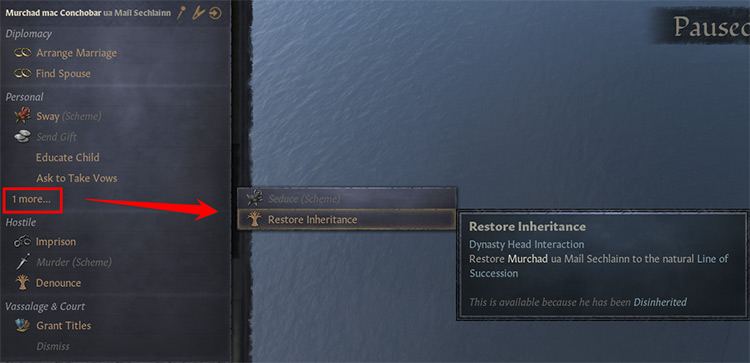This is a common strategy used to choose heirs in early to mid-game before primogeniture succession is unlocked.
How To Disinherit an Heir
To disinherit a character, right click on their portrait and find the “hostile” subheading. Click on “more” to reveal the disinherit action. Note: You will only have the disinherit option if you are the current head of your dynasty. Disinheriting a character costs prestige and renown. This cost increases based on whether the character is set to inherit land or holds any land currently. The cost scales as follows: If you can afford to spend those resources and click on “Disinherit,” the character will receive the “Disinherited” trait.
How Disinheriting Works
Disinherited characters cannot inherit any titles from your dynasty. This includes any other family member in the dynasty, not just you! You cannot play as disinherited characters if you die. A disinherited character can still inherit titles from other dynasties, for example, from their other parent or the death of their vassal. You can also reverse the disinherit action at any time by clicking “restore inheritance”, as long as you have 75 renown to spare. This cost never changes.
Why Should You Disinherit?
Disinheriting is a very useful tool, especially in early to mid-game. But is it worth the cost?
Benefits
- The main benefit is complete control of your succession. You can easily choose your next heir, even if you still have partition forms of succession.
- This also allows you to choose your best heir, regardless of age or popularity. Perfect for players collecting inheritable traits!
- When you do die and begin playing your heir you might have fewer claimants challenging your rule.
- Finally, reversing this action is instant and relatively cheap at 75 renown, so it doesn’t require a lot of commitment. This is a flat cost even if the character is landed.
Drawbacks
- The first negative you’ll encounter is the cost. It can take some time to get 75 renown as a new dynasty, and it’s even harder to get 150 if you want to disinherit your main heir. Tip: If you want to disinherit many children or heirs, disinherit the characters who are last in line to inherit first. That way, you only have to spend 75 renown for some of them instead of 150.
- Spending all of this renown slows down your dynasty upgrades too. These are very powerful so you might not want to miss out.
- If you disinherit all of your children except one, your chosen heir may die before you. You’d need to spend 75 renown to restore another heir or face a game over if you die!
- There is a large relationship debuff from this action. While positive interactions can balance it out again, this might push some characters into plotting against you.
- Remember that disinherited heirs can still inherit lands from characters outside of your dynasty. If you married a powerful ruler to take their lands when you die, you can’t change the heir of those titles through disinheriting.
Is It Worth Disinheriting?
In summary, disinheriting is a valuable tool that can completely control your succession. Until you reach the milestone of primogeniture after 1200AD, you may be relying on the disinherit action if you want to keep your lands completely intact. While it can be well worth the cost, be careful how many heirs you disinherit at the start of the game. If you get really unlucky this can be a game over!








